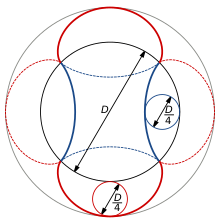Cycloid gear
The cycloidal gear profile is a form of toothed gear used in mechanical clocks, rather than the involute gear form used for most other gears. The gear tooth profile is based on the epicycloid and hypocycloid curves, which are the curves generated by a circle rolling around the outside and inside of another circle, respectively.
When two toothed gears mesh, an imaginary circle, the pitch circle, can be drawn around the centre of either gear through the point where their teeth make contact. The curves of the teeth outside the pitch circle are known as the addenda, and the curves of the tooth spaces inside the pitch circle are known as the dedenda. An addendum of one gear rests inside a dedendum of the other gear.
In cycloidal gears, the addenda of the wheel teeth are convex epi-cycloidal and the dedenda of the pinion are concave hypocycloidal curves generated by the same generating circle. This ensures that the motion of one gear is transferred to the other at locally constant angular velocity.
The size of the generating circle (pinion) may be freely chosen, mostly independent of the number of teeth.

A Roots blower is one extreme, a form of cycloid gear where the ratio of the pitch diameter to the pinion diameter equals twice the number of lobes. In a two-lobed blower, the pinion is one-fourth the diameter of the pitch circles, and the teeth form complete epi- and hypo-cycloidal arcs.
In clockmaking, the pinion diameter is commonly chosen to be one-half the pitch diameter of one of the gears. This results in a dedendum which is a simple straight radial line. This is simple to polish, and the lack of any undercut strengthens the tooth. The addenda are not complete epicycloids, but portions of two different ones which intersect at a point, resulting in a "gothic arch" tooth profile.
There is some dispute over the invention of cycloidal gears. Those involved include Gérard Desargues, Philippe de La Hire, Ole Rømer, and Charles Étienne Louis Camus.
See also
References
External links
- Designing cycloidal gears
- Kinematic Models for Design Digital Library (KMODDL)
Movies and photos of hundreds of working mechanical-systems models at Cornell University. Also includes an e-book library of classic texts on mechanical design and engineering. - 2 and 4-cog cycloidal gears in motion